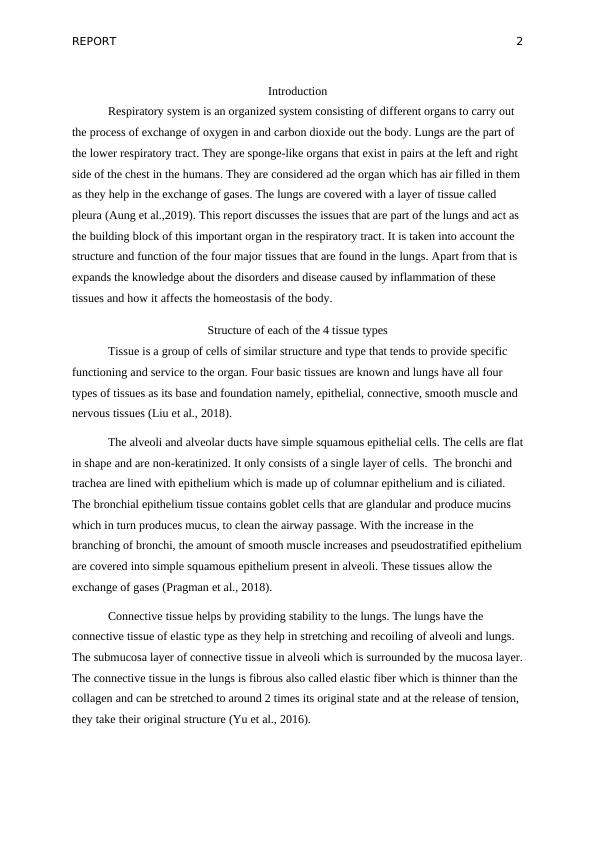Structure of Tissues | Anatomy and Physiology
Added on 2022-09-14
6 Pages1487 Words70 Views
Anatomy and
Physiology
Biology
REPORT 0
Physiology
Biology
REPORT 0

REPORT 1
Contents
Introduction................................................................................................................................2
Structure of each of the 4 tissue types........................................................................................2
Dysfunction of Tissues...............................................................................................................3
Tissue disfunction and Homeostasis..........................................................................................3
Conclusion..................................................................................................................................4
References..................................................................................................................................5
Contents
Introduction................................................................................................................................2
Structure of each of the 4 tissue types........................................................................................2
Dysfunction of Tissues...............................................................................................................3
Tissue disfunction and Homeostasis..........................................................................................3
Conclusion..................................................................................................................................4
References..................................................................................................................................5

REPORT 2
Introduction
Respiratory system is an organized system consisting of different organs to carry out
the process of exchange of oxygen in and carbon dioxide out the body. Lungs are the part of
the lower respiratory tract. They are sponge-like organs that exist in pairs at the left and right
side of the chest in the humans. They are considered ad the organ which has air filled in them
as they help in the exchange of gases. The lungs are covered with a layer of tissue called
pleura (Aung et al.,2019). This report discusses the issues that are part of the lungs and act as
the building block of this important organ in the respiratory tract. It is taken into account the
structure and function of the four major tissues that are found in the lungs. Apart from that is
expands the knowledge about the disorders and disease caused by inflammation of these
tissues and how it affects the homeostasis of the body.
Structure of each of the 4 tissue types
Tissue is a group of cells of similar structure and type that tends to provide specific
functioning and service to the organ. Four basic tissues are known and lungs have all four
types of tissues as its base and foundation namely, epithelial, connective, smooth muscle and
nervous tissues (Liu et al., 2018).
The alveoli and alveolar ducts have simple squamous epithelial cells. The cells are flat
in shape and are non-keratinized. It only consists of a single layer of cells. The bronchi and
trachea are lined with epithelium which is made up of columnar epithelium and is ciliated.
The bronchial epithelium tissue contains goblet cells that are glandular and produce mucins
which in turn produces mucus, to clean the airway passage. With the increase in the
branching of bronchi, the amount of smooth muscle increases and pseudostratified epithelium
are covered into simple squamous epithelium present in alveoli. These tissues allow the
exchange of gases (Pragman et al., 2018).
Connective tissue helps by providing stability to the lungs. The lungs have the
connective tissue of elastic type as they help in stretching and recoiling of alveoli and lungs.
The submucosa layer of connective tissue in alveoli which is surrounded by the mucosa layer.
The connective tissue in the lungs is fibrous also called elastic fiber which is thinner than the
collagen and can be stretched to around 2 times its original state and at the release of tension,
they take their original structure (Yu et al., 2016).
Introduction
Respiratory system is an organized system consisting of different organs to carry out
the process of exchange of oxygen in and carbon dioxide out the body. Lungs are the part of
the lower respiratory tract. They are sponge-like organs that exist in pairs at the left and right
side of the chest in the humans. They are considered ad the organ which has air filled in them
as they help in the exchange of gases. The lungs are covered with a layer of tissue called
pleura (Aung et al.,2019). This report discusses the issues that are part of the lungs and act as
the building block of this important organ in the respiratory tract. It is taken into account the
structure and function of the four major tissues that are found in the lungs. Apart from that is
expands the knowledge about the disorders and disease caused by inflammation of these
tissues and how it affects the homeostasis of the body.
Structure of each of the 4 tissue types
Tissue is a group of cells of similar structure and type that tends to provide specific
functioning and service to the organ. Four basic tissues are known and lungs have all four
types of tissues as its base and foundation namely, epithelial, connective, smooth muscle and
nervous tissues (Liu et al., 2018).
The alveoli and alveolar ducts have simple squamous epithelial cells. The cells are flat
in shape and are non-keratinized. It only consists of a single layer of cells. The bronchi and
trachea are lined with epithelium which is made up of columnar epithelium and is ciliated.
The bronchial epithelium tissue contains goblet cells that are glandular and produce mucins
which in turn produces mucus, to clean the airway passage. With the increase in the
branching of bronchi, the amount of smooth muscle increases and pseudostratified epithelium
are covered into simple squamous epithelium present in alveoli. These tissues allow the
exchange of gases (Pragman et al., 2018).
Connective tissue helps by providing stability to the lungs. The lungs have the
connective tissue of elastic type as they help in stretching and recoiling of alveoli and lungs.
The submucosa layer of connective tissue in alveoli which is surrounded by the mucosa layer.
The connective tissue in the lungs is fibrous also called elastic fiber which is thinner than the
collagen and can be stretched to around 2 times its original state and at the release of tension,
they take their original structure (Yu et al., 2016).

End of preview
Want to access all the pages? Upload your documents or become a member.
Related Documents
Department of Health & Human Serviceslg...
|12
|1373
|25
Structure and Function of the Respiratory Systemlg...
|19
|3797
|442
Human Physiology Assignment- Respiratory Systemlg...
|9
|2071
|150
Human Anatomy and Physiology Assignmentlg...
|11
|1865
|434
How to Write Your First Research Paper -lg...
|8
|1998
|16
Fundamentals of Human Anatomy and Physiology: Respiratory System Worksheetlg...
|8
|2117
|4